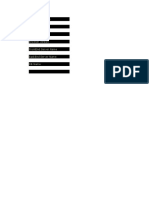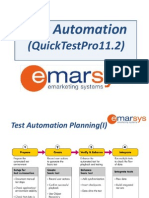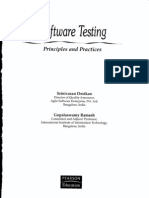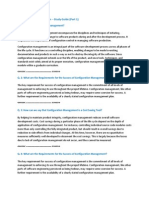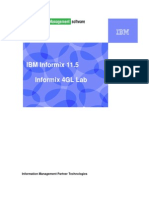0 ratings0% found this document useful (0 votes)
386 viewsParasoft API Testing Guide
Parasoft API Testing Guide
Uploaded by
DanCopyright
© © All Rights Reserved
Available Formats
Download as PDF, TXT or read online on Scribd
0 ratings0% found this document useful (0 votes)
386 viewsParasoft API Testing Guide
Parasoft API Testing Guide
Uploaded by
DanCopyright
© © All Rights Reserved
Available Formats
Download as PDF, TXT or read online on Scribd
You are on page 1/ 8
API Testing:
Challenges and Best Practices
1
Modern composite applications are aggregating and consuming private, partner, and public APIs
at a staggering pace in order to achieve business goals. ProgrammableWeb reports that there
are over 10,000 APIs published today which is well over twice as many than there were two
years ago.
1
Beyond these publically-exposed APIs, the number of private APIs is estimated to be
in the millions.
As the risks associated with application failure have broader business impacts, the integrity of the
APIs you produce and consume is now more important than ever. An API that fails to deliver the
expected level of security, reliability, and performance can thus have tremendous business
impactsboth to the organization producing it and to those consuming it.
If you are integrating exposed APIs into your business critical transactions, you are essentially
assuming the risks associated with that API's integrity (or lack thereof). As the number of external
APIs integrated into a business process increases, so do the potential points of failure. The
business impact of any application failure is the same, regardless of whether the fault lies within
the components you developed or the APIs you are consuming. Finger pointing does little to
foster customer satisfaction and brand loyalty.
If you are exposing an API, the assumption is that it will work as described. Once the
organizations consuming that API integrate this exposed functionality into their own applications,
API failure jeopardizes the transactions that now depend on this functionality. If your API is
popular, you can guarantee that a glitch will make the headlines. The more secure, reliable, and
dependable your API, the better the chance of consumption and the greater the potential for
business expansion. If youre providing a questionable interface and there are viable alternatives
to your API, youre likely to lose business since switching costs associated with API integration
are so low.
4 Integrity Challenges with the API Economy
In today's API economy, your ability to protect your brand hinges upon your awareness of (and
response to) the following challenges
1. Broader Attack Surface Area
Simply exposing an API through an internal infrastructure undeniably increases an applications
attack surface area from a security perspective. It could be vulnerable to API-level attacks
(injections, payload-based attacks, etc.) as well as exploits that take advantage of ineffective
authentication, encryption, and access control. The challenge of broader attack surface area is
compounded if the API is hosted by a public cloud service. In traditional computing, the producer
is aware of (and has full control over) the parameters of the network security. With cloud services,
this level of control is significantly diminished. If youre now leveraging a third-party set of
services, the onus is upon you to ensure that your APIs will provide the level of security that your
organization expects.
1
http://blog.programmableweb.com/2013/09/23/programmablewebs-directory-hits-10000-apis-and-counting/
2
2. Elevated Potential for Unexpected Misuse
Considering the range and number of people who will have access to published APIs, its virtually
inevitable that they will be exercised in a number of unexpected ways: both by people innocently
using them in ways the producer never anticipated and by attackers maliciously trying to exploit
them. In the early days of SOAwhen services were exposed internally through controlled
networksyou could be fairly certain that your services would be used by colleagues or partners
who were familiar with their intended uses cases. Now, when an API is exposed to the public, the
producer surrenders all control and certainty over how those APIs are consumed.
3. Exceptionally Unpredictable Demand
APIs typically need to meet established performance SLAs; however, validating performance vs.
SLAs is complicated because its so difficult to predict how and when the API might be accessed.
Thus, its important to validate performance SLAs against a broad range of performance
scenarios, including the sudden surges that could occur if an API garners unexpected attention.
Moreover, if youre testing an API that interacts with additional layers of services, the potential for
variable or unacceptable performance increases exponentially. This makes it both more critical
and more challengingto execute a robust set of performance testing scenarios and pinpoint
whether the system under test satisfies expectations.
4. API Consumers Need Test Environments
To promote widespread adoption of APIs, its often desirable to provide API consumers test
environments (a.k.a. sandboxes) that enable them to develop and test against exposed services
with zero impact on the production system. Such test environments are also critical when API
producers want to jumpstart adoption by allowing integration to begin before their API is actually
implemented or before new features are fully completed. Another key driver for providing a test
environment is to give API consumers easy access to the broad range of behavior, data, and
performance profiles they might want to leverage for testing their integration with that API.
5 API Testing Must Haves
Ensuring that APIs are delivering the necessary level of security, reliability, and performance
thats vital to success in todays API ecosystem inevitably involves developing, continuously
executing, and religiously maintaining a broad array of complex tests. Following are several key
API testing must haves that will help you achieve those goals in light of the above challenges.
1. Intelligent Test Creation and Automated Validation
With APIs, testing a broad range of conditions and corner cases is critical, so automation comes
to the forefront. The creation and execution of simple automated tests with limited or manual
validation might have sufficed for internal given web services that were used internally (e.g., via
SOA), but more sophisticated and extensive automation is required to be confident that APIs are
robust enough to meet business expectations. You need a level of automation that gives you a
comprehensive set of functional test cases that can be repeated in a systematic manner.
3
Recommended capabilities for this goal include an intuitive interface for automating complex
scenarios across the messaging layer, ESBs, databases, and mainframes:
Defining automated test scenarios across the broad range of protocols and message
types used in APIs: REST, WADL, JSON, MQ, JMS, EDI, fixed-length messages, etc.
Automating rich multilayer validation across multiple endpoints involved in end-to-end test
scenarios.
Parameterizing test messages, validations, and configurations from data sources, values
extracted from test scenarios, or variables.
Defining sophisticated test flow logic without requiring scripting.
Visualizing how messages and events flow through distributed architectures as tests
execute.
These are all capabilities that shouldor at least couldhave been applied to web service
testing for SOA. In fact, most of these capabilities were invented, tested, and refined in the
context of SOA testing. APIswith their extreme exposure and myriad opportunities for misuse
brings us to the tipping point that makes these automated testing and validation capabilities a
must have for organizations serious about delivering APIs that satisfy user needs and
expectations.
2. Change Management for Test Assets and Environments
Continuously evolving APIs helps organizations stay a step ahead of the competition while
responding to business demands. Yet, this frequent change presents significant quality risks if the
automated test suite fails to keep pace with the evolving API.
A system for fast, easy, and accurate updating of test assets is critical for keeping test assets in
sync with the changing API. If you can automatically assess the impact of changes to existing
tests and then quickly update existing tests (or create new ones) in response to the identified
change impacts, you can vastly reduce the amount of time required to ensure that your tests dont
fail due to expected changesor overlook critical new functionality.
3. Service Virtualization for Simulated Test Environments
Service Virtualization technology creates simulated test environments that provide anytime,
anywhere access to the behavior of dependent resources that are unavailable, difficult to access,
or difficult to configure for development or testing. Dependent resources might include
mainframes, mobile app front-ends, databases, web services, third-party applications, or other
systems that are out of your teams direct control. Service virtualization can be used in
conjunction with hardware/OS virtualization to access the environments you need to test earlier,
faster, or more completely.
In the context of API testing, service virtualization can be applied in two key ways:
To simulate access to the dependent resource behavior (e.g., from a mobile app,
database, legacy system, or third-party service) that you need in order to thoroughly
validate your API.
4
To simulate the behavior of your APIs, creating a test environment that API consumers
can develop and test against without impacting your production environmentor to
enable development and testing to begin before APIs are completed.
4. Extensive Performance TestingIdeally, with Service Virtualization
Due to the highly-exposed nature of APIs, theres a high potential for unpredictable and often
volatile traffic volumes. To determine whether your API will satisfy SLAs in the event of the erratic
or surging demand that APIs commonly face, its essential to ramp up the scope of performance
testing. You can use service virtualization (covered above) to create simulated test environments
that help you test against different performance scenarios that would otherwise be difficult to
create in the test environment.
For instance, you can easily set performance conditions (e.g., timing, latency, delay) to emulate
peak, expected, and slow performanceperhaps to help you plan for cloud bursts or determine
how the API might respond when someone is accessing it from China. You can also configure
various error and failure conditions that are difficult to reproduce or replicate with real systems
for instance, if your APIs rely on Amazon Web Services, you can easily simulate a scenario
where AWS is down. This ability to rapidly configure a broad range of conditions in dependent
systems is essential for determining if your APIs provide reasonable responsesor at least fail
gracefullyunder exceptional conditions.
One final way that adopting service virtualization helps performance testing: you can virtualize
any connections to third-party systems, reliably eliminating the risk that your stress tests might
impact services you arent permitted (or budgeted) to barrage with test messages.
5. Extensive Security TestingIdeally, with Service Virtualization
Considering APIs increased attack surface area, a multi-faceted security testing strategy is
essential for ensuring that development has built the appropriate level of security into your
application. This includes:
Executing complex authentication, encryption, and access control test scenarios.
Generating a broad range of penetration attack scenarios involving parameter fuzzing,
injections, large payloads, etc.
Running penetration attack scenarios against your existing functional test scenarios.
Monitoring the back-end during test execution in order to determine whether security is
actually compromised.
In addition, if youre adopting service virtualization (covered above) you can leverage it to take
your security testing to the next level:
It provides rapid ways to emulate attack scenarios as well as emulate different security
behaviors of dependencies. This lets you derive more value from your existing functional
test scenarios (since you can run them vs. different security scenarios that would
otherwise be difficult to configure and unfeasible to test against).
It enables extensive security testing to be performed without a security expert. Existing
test scenarios can be easily executed against a broad set of preconfigured security
scenarios.
It helps you isolate and zero in on your APIs response to various attack scenarios and
different security behaviors of dependencies.
5
About Parasoft
For 25 years, Parasoft has researched and developed software solutions that help organizations
define and deliver defect-free software efficiently. By integrating Development Testing, cloud/API
testing, and service virtualization, we reduce the time, effort, and cost of delivering secure,
reliable, and compliant software. Parasoft's enterprise and embedded development solutions are
the industry's most comprehensiveincluding static analysis, unit testing, requirements
traceability, functional & load testing, dev/test environment management, and more. The majority
of Fortune 500 companies rely on Parasoft in order to produce top-quality software consistently
and efficiently. For more information, visit the Parasoft web site and ALM Best Practices blog.
Contacting Parasoft
USA Phone: (888) 305-0041 Email: info@parasoft.com
NORDICS Phone: +31-70-3922000 Email: info@parasoft.nl
GERMANY Phone: +49 731 880309-0 Email: info-de@parasoft.com
POLAND Phone: +48 12 290 91 01 Email: info-pl@parasoft.com
UK Phone: +44 (0)208 263 6005 Email: sales@parasoft-uk.com
FRANCE Phone: (33 1) 64 89 26 00, Email: sales@parasoft-fr.com
ITALY Phone: (+39) 06 96 03 86 74 Email: c.soulat@parasoft-fr.com
OTHER See http://www.parasoft.com/contacts
Author Information
This paper was written by:
Wayne Ariola (wayne.ariola@parasoft.com), VP of Strategy at Parasoft
Cynthia Dunlop (cynthia.dunlop@parasoft.com), Lead Technical Writer at Parasoft
2013 Parasoft Corporation
All rights reserved. Parasoft and all Parasoft products and services listed within are trademarks or registered trademarks of Parasoft Corporation. All other
products, services, and companies are trademarks, registered trademarks, or servicemarks of their respective holders in the US and/or other countries.
Parasoft API Testing Solution / Data Sheet 1
Modern composite applications are aggregating and consuming private, partner, and public APIs at a staggering pace
in order to achieve business goals. As applications grow increasingly interdependent, the security, functionality, and
performance of the composite mashup is only as strong as its weakest link. The success of an end-to-end transaction
depends upon all the parts working fawlessly all the time; even small glitches from a popular API can singlehandedly
choke thousands of transactions.
Ensuring API integrity is complicated by a number of factors:
Extensive testing is required to ensure that APIs will satisfy expectations
under the extreme conditions they might face in the feld
Validating end-to-end test scenarios typically requires access
to third-party systems that are often unavailable or ofine
Each of the many continuously-evolving components involved
in modern applications requires very specialized domain expertise
to test and analyze
Manual testing efforts lack the breadth, depth, and repeatability
that is critical for identifying application risks prior to production
Without an enterprise-level automated solution for ensuring the integrity of
APIs and API-driven applications, organizations risk:
Brand erosion as faulty software drives away customers
Time-to-market delays that diminish market share
Exposure to legal liability associated with application failure
Failure to comply with applicable regulatory standards and technical contracts
Ensure that interconnected applications meet expectations
Parasofts API Testing solution was built from the ground up to simplify the complex testing thats vital for secure, reliable,
and compliant composite applications. The result:
Reduced costs by reducing testing costs, reducing technical debt, and exposing defects earlier in the SDLC
Reduced risks by applying more exhaustive testing techniques, increasing test coverage,
and immediately exposing any defects introduced by modifcations
Increased efciency by leveraging sophisticated automation and enabling artifact reuse
An API Testing solution is commonly applied in the following situations:
Complex composite applications: To visualize and validate how messages and
events fow through the distributed architecture as tests execute
Cloud-based applications: To facilitate cloud migration and ensure functionality,
security, and performance expectations are met in dynamic environments
Mobile development: To ensure the continued functionality, security, and performance
of the frequently-evolving APIs that drive mobile applications
End-to-end functional testing: To automate and analyze test scenarios across the many
disparate, specialized endpoints involved in a single business transaction
Parasoft API Integrity
Parasoft Corporation All rights reserved. Parasoft and all Parasoft products and services listed within are trademarks or registered trademarks of Parasoft Corporation.
All other products, services, and companies are trademarks, registered trademarks, or servicemarks of their respective holders in the US and/or other countries.
USA PARASOFT HEADQUARTERS / 101 E. Huntington Drive, Monrovia, CA 91016
Phone: (888) 305-0041 / Email: info@parasoft.com
Parasoft API Testing successes include:
AT&T: To ensure the reliability of iPhone
billing systems
IRS: To ensure the accuracy and performance
of corporate tax e-fling systems
CDC: To validate rule-based specimen
management systems
Sabre: To ensure the reliability of the worlds
largest travel network
Cisco: To audit business processes
IBM: To enforce governance policies
Fidelity Investments: To create and
manage emulated service assets
HP: To validate complex business scenarios
Vanguard: To ensure expected quality of service
Bloomberg: To validate performance
expectations
MedicAlert: To safeguard personal health
record management services
Siemens: To ensure secure, reliable account
management and email services
Lufthansa: To ensure that cargo shipments
are planned and fulflled fawlessly
Built from the ground up for message-layer
testing; industry gold standard since 2002
From a single intuitive interface, automate
complex end-to-end scenarios across
multiple endpoints (services, databases,
Web UI, ESBs, mainframes)
Leverage broad, fexible support for
protocols, transports, message formats
Automatically generate tests that are robust,
reusable, and easily shareable
Keep test assts in sync with evolving systems
via automated intelligent updating
Visualize and validate how messages and
events fow through distributed architectures
as tests execute
Seamlessly integrate functional testing
with load testing, service virtualization, and
development testing
Real Results
Key Features
Parasoft API Testing Solution
Parasofts comprehensive enterprise-grade solution dramatically
simplifes the complex testing needed for todays interconnected
business systems.
Simple Generation of Flexible, Extensible Tests
From a user-friendly interface, generate tests by monitoring live
application trafc or analyzing key application resources. Intuitive
GUIs visualize message structures, making it simple to fne-tune test
messages and validations for GUI-less services and APIs. Parasofts
tests are engineered for easy sharing, reuse, and extension.
Repeatable Automated End-to-End Testing
Using automatically-generated tests as building blocks, rapidly
defne complex test scenarios that exercise and validate business
transactions across multiple endpoints. From the messaging layer,
to the web UI, to the database, ESB, and mainframes, the intuitive
interface makes it simple to validate whether business logic
satisfes expectations. Easy integration with continuous integration
platforms ensures that critical errors are exposed immediately
upon introduction.
Simulate the Behavior of Dependencies
Testing efforts are often delayed and/or compromised due to
difculty accessing or confguring dependent components (3rd
party applications or services, databases, mainframes, etc.).
Parasoft Service Virtualization enables rapid, fexible simulation of
these dependencies behavior, giving functional and performance
testers unconstrained access toand unparalleled control
overthe dependent components they need to test against. This
promotes earlier, faster, and more complete testing.
Technologies & Protocols
Parasoft supports all the standard protocols and technologies, including:
REST / SOAP / JSON / JMS / MQ / NET WCF / TCP/IP / FTP / EDI / EDIFACT
HL7 / X12 / HIPAA / ISO 8583 / WSDL / WADL / WS-* / XML/PoX / UDDI
WSIL / BPEL / RMI / EJB / webMethods / TIBCO / SMTP / ISO 8583 / JSON /
HTTP/HTTPS / ebXML / Equifax / JDBC / ODBC / Java Objects / Fixed Length /
Bytes/Binary / custom / more
You might also like
- What Men Dont Want Women To Know - The Secrets, The Lies, The Unspoken Truth - Smith and Doe90% (20)What Men Dont Want Women To Know - The Secrets, The Lies, The Unspoken Truth - Smith and Doe157 pages
- 7839+ Awesome Deep Web Onion Links List (Uncensored Content) PDF74% (35)7839+ Awesome Deep Web Onion Links List (Uncensored Content) PDF391 pages
- Darknet-Bible - Everything You Need To Know To Order Safely at Darknet Markets100% (3)Darknet-Bible - Everything You Need To Know To Order Safely at Darknet Markets218 pages
- Organizing Solutions For People With ADHD, 2nd Edition-Revised and Updated95% (58)Organizing Solutions For People With ADHD, 2nd Edition-Revised and Updated221 pages
- Sunbeam Popcorn Maker FPSBPP7310 FPSBPP731660% (10)Sunbeam Popcorn Maker FPSBPP7310 FPSBPP73169 pages
- 30 Best Tor Sites For Any and Everything You'll Ever Need! - Your Hacker90% (29)30 Best Tor Sites For Any and Everything You'll Ever Need! - Your Hacker8 pages
- Side Hustle Bible (James Altucher) (Z-Library)100% (3)Side Hustle Bible (James Altucher) (Z-Library)197 pages
- 7839+ Awesome Deep Web Onion Links List (Uncensored Content)50% (4)7839+ Awesome Deep Web Onion Links List (Uncensored Content)54 pages
- The Art of Invisibility - The World's Most Famous Hacker Teaches You How To Be Safe in The Age of Big Brother and Big Data - PDF Room100% (2)The Art of Invisibility - The World's Most Famous Hacker Teaches You How To Be Safe in The Age of Big Brother and Big Data - PDF Room252 pages
- Testing Tools and Libraries Every Java Developer Must Know Sample ChapterNo ratings yetTesting Tools and Libraries Every Java Developer Must Know Sample Chapter17 pages
- IBM Product Master 12.0 Functional OverviewNo ratings yetIBM Product Master 12.0 Functional Overview26 pages
- Certified API Testing Professional BrochureNo ratings yetCertified API Testing Professional Brochure6 pages
- Functional Test Automation:: A Complete Introduction ToNo ratings yetFunctional Test Automation:: A Complete Introduction To47 pages
- A Complete I Troduction To: Functional Test AutomationNo ratings yetA Complete I Troduction To: Functional Test Automation57 pages
- Overview On Cloud Computing and Performance TestingNo ratings yetOverview On Cloud Computing and Performance Testing20 pages
- 10 Performance Bottlenecks in Web ApplicationNo ratings yet10 Performance Bottlenecks in Web Application7 pages
- Certified Mobile Testing (Appium) Professional VS-1425No ratings yetCertified Mobile Testing (Appium) Professional VS-14256 pages
- Compare Performance, Load, Stress TestingNo ratings yetCompare Performance, Load, Stress Testing6 pages
- Step by Step Guide To Implement Proof of Concept (POC) in Automation Testing - 3No ratings yetStep by Step Guide To Implement Proof of Concept (POC) in Automation Testing - 32 pages
- Appium Training Complete Tutorial - Appium TrainingNo ratings yetAppium Training Complete Tutorial - Appium Training9 pages
- Testing Mobile Applications Using Perfecto Mobile MobileCloud V2No ratings yetTesting Mobile Applications Using Perfecto Mobile MobileCloud V249 pages
- Lecture 3 Introduction To Software TestingNo ratings yetLecture 3 Introduction To Software Testing51 pages
- Difference Between Verification & ValidationNo ratings yetDifference Between Verification & Validation11 pages
- Full Download (eBook PDF) Foundations of Software Testing ISTQB Certification, 4th edition PDF DOCX100% (4)Full Download (eBook PDF) Foundations of Software Testing ISTQB Certification, 4th edition PDF DOCX46 pages
- Ultimate Web Automation Testing with Cypress: Master End-to-End Web Application Testing Automation to Accelerate Your QA Process with CypressFrom EverandUltimate Web Automation Testing with Cypress: Master End-to-End Web Application Testing Automation to Accelerate Your QA Process with CypressNo ratings yet
- The Complete Spring Boot: A Comprehensive Guide to Modern Java ApplicationsFrom EverandThe Complete Spring Boot: A Comprehensive Guide to Modern Java ApplicationsNo ratings yet
- AWS Fully Loaded: Mastering Amazon Web Services for Complete Cloud SolutionsFrom EverandAWS Fully Loaded: Mastering Amazon Web Services for Complete Cloud SolutionsNo ratings yet
- 10 Useful Websites You Wish You Knew Earlier! 6 (2017)0% (1)10 Useful Websites You Wish You Knew Earlier! 6 (2017)21 pages
- 6 Steps To SOA - Torry Harris WhitepaperNo ratings yet6 Steps To SOA - Torry Harris Whitepaper3 pages
- How Distributed Computing Systems Are Going To Be Evolved in Future and Explain It Briefly Mentioning100% (2)How Distributed Computing Systems Are Going To Be Evolved in Future and Explain It Briefly Mentioning10 pages
- Oracle Business Process Management: Tutorial Lab Project (INN696-1, Semester 1/2014) Loan Assessment ProcessNo ratings yetOracle Business Process Management: Tutorial Lab Project (INN696-1, Semester 1/2014) Loan Assessment Process6 pages
- 2.4c Informix Application Development 4GL LabNo ratings yet2.4c Informix Application Development 4GL Lab36 pages
- (Ebook) Proceedings of International Conference on ICT for Sustainable Development: ICT4SD 2015 Volume 2 by Suresh Chandra Satapathy, Amit Joshi, Nilesh Modi, Nisarg Pathak (eds.) ISBN 9789811001338, 9789811001352, 9811001332, 9811001359 download pdf100% (13)(Ebook) Proceedings of International Conference on ICT for Sustainable Development: ICT4SD 2015 Volume 2 by Suresh Chandra Satapathy, Amit Joshi, Nilesh Modi, Nisarg Pathak (eds.) ISBN 9789811001338, 9789811001352, 9811001332, 9811001359 download pdf65 pages
- Taxonomy of Automated Software Testing Tools: Kamran Shaukat, Usman Shaukat, Faran Feroz, Shahraiz Kayani, Ali AkbarNo ratings yetTaxonomy of Automated Software Testing Tools: Kamran Shaukat, Usman Shaukat, Faran Feroz, Shahraiz Kayani, Ali Akbar12 pages
- Service Oriented Architecture For The Batch Control Domain: November 2011No ratings yetService Oriented Architecture For The Batch Control Domain: November 20115 pages
- Internet of Things in Industries: A Survey: Li Da Xu, Senior Member, IEEE, Wu He, and Shancang LiNo ratings yetInternet of Things in Industries: A Survey: Li Da Xu, Senior Member, IEEE, Wu He, and Shancang Li11 pages
- DS Session 11 - Service Oriented ArchitectureNo ratings yetDS Session 11 - Service Oriented Architecture4 pages
- Performance and Dependability in Service Computing Concepts Techniques and Research Directions 1st Edition Valeria Cardellini All Chapters Instant Download100% (20)Performance and Dependability in Service Computing Concepts Techniques and Research Directions 1st Edition Valeria Cardellini All Chapters Instant Download50 pages
































